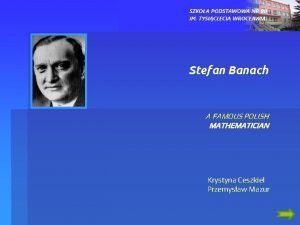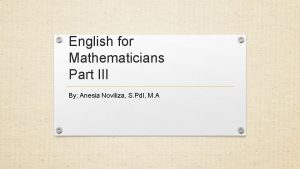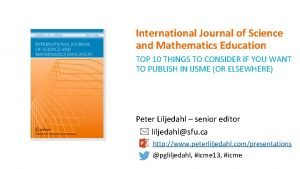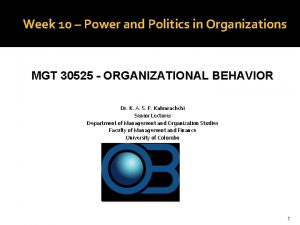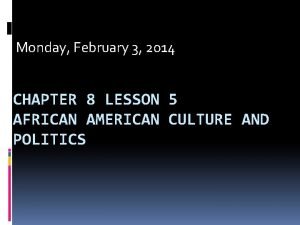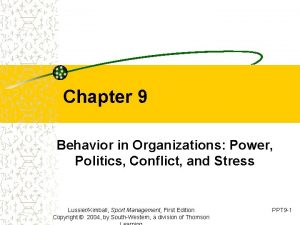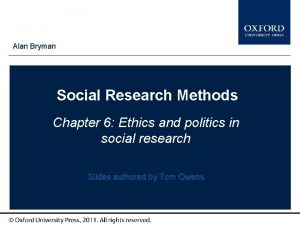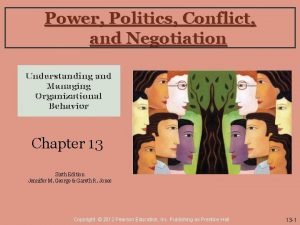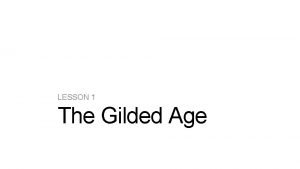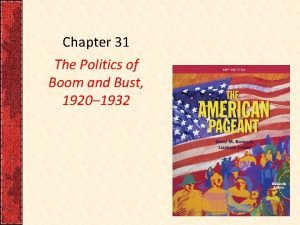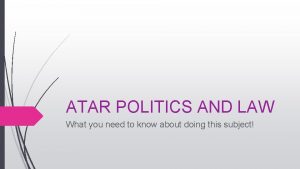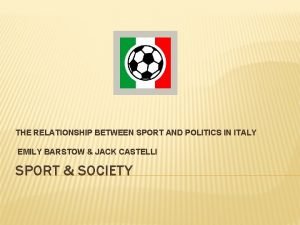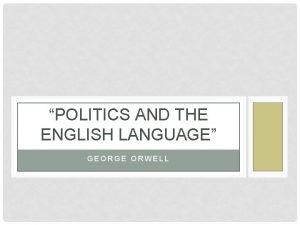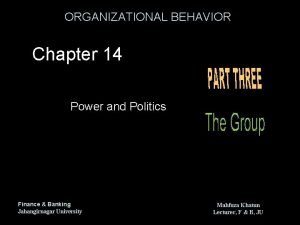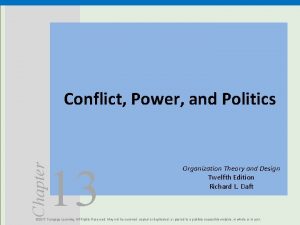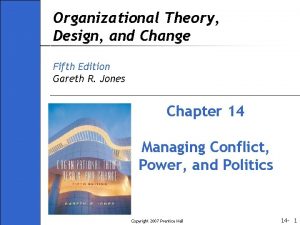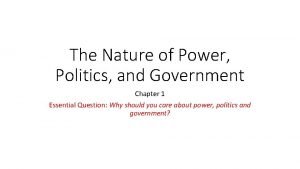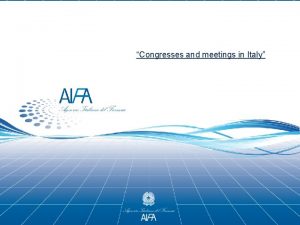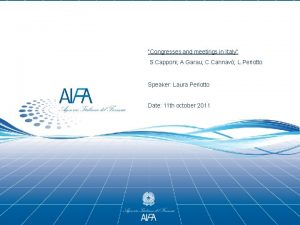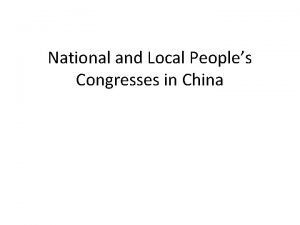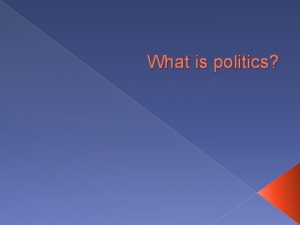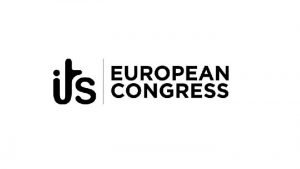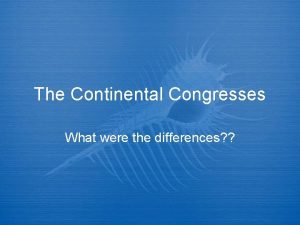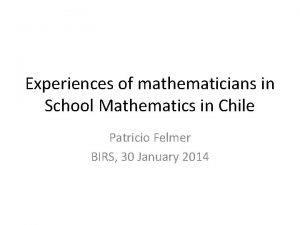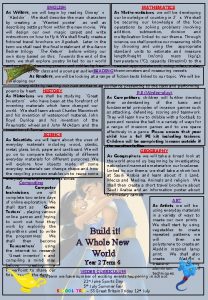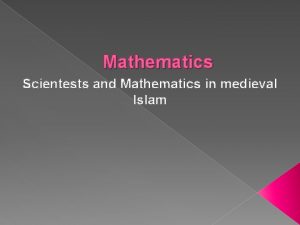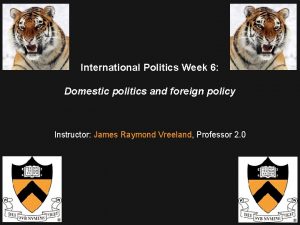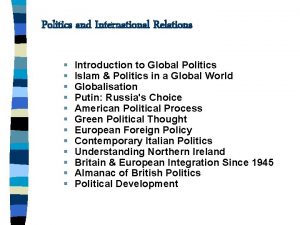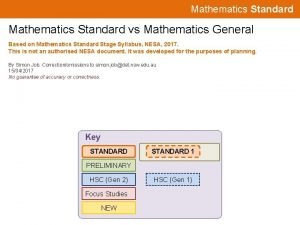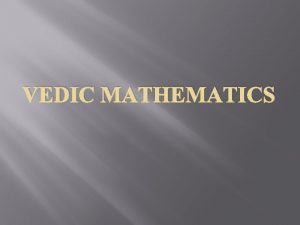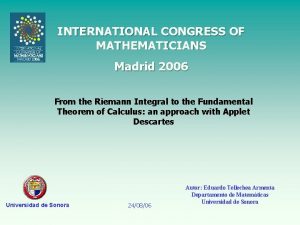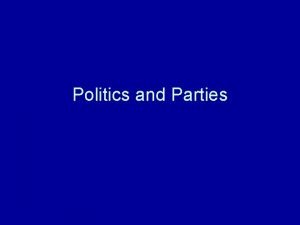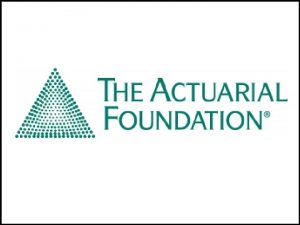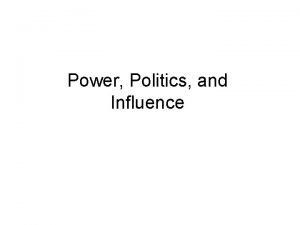The International Congresses of Mathematicians politics and mathematics






































- Slides: 38

The International Congresses of Mathematicians - politics and mathematics Edmund F Robertson University of St Andrews

The lead-up to the Congresses The first International Congress took place in 1897 but before we look at this we will look briefly at the events leading up to this Congress. There were two influential people whose efforts were vital in promoting the idea of international mathematical conferences, namely Felix Klein and Georg Cantor.

Klein and Cantor Both Klein and Cantor strongly believed in international collaboration in mathematics. Their aims were the same but both were motivated by different personal reasons.

Cantor and Klein’s motives • Cantor felt his close colleagues were making unfair criticism of his work so he wanted a broader platform to promote his ideas. • Klein had strong ideas about teaching mathematics and mathematical research and was a great organiser who wanted to see his ideas placed on a broader stage.

The 1897 Congress in Zurich • In 1888 Cantor proposed a meeting between German and French mathematicians and later, between 1894 and 1896, he contacted several leading mathematicians proposing an international conference. He had support from Felix Klein, Heinrich Weber, Emile Lemoine and others. Cantor proposed that a trial conference be held in 1897, either in Switzerland or Belgium.

Karl Geiser and Ferdinand Rudio • Now if Cantor and Klein were the most influential in advocating international congresses, the two people who have been most influential in setting the shape of the whole series of congresses were Karl Geiser and Ferdinand Rudio. Geiser was the Professor of Mathematics at the Polytechnic in Zurich

Karl Geiser and Ferdinand Rudio Karl Geiser, was elected president of the Congress, and Rudio was one of the two secretaries. The Congress was attended by 208 full members and 38 associate members.

Rudio’s contribution • The importance of Rudio's contribution is often overlooked. He presented On the tasks and the organization of international mathematical congresses which set out the aims and structures of future congresses. In many aspects, the 21 st century congresses are still influenced by these ideas.

The 1900 Congress in Paris David Hilbert's lecture on the future problems of mathematics became the most famous lecture delivered at any International Congress of Mathematicians.


Weakness of Paris 1 • Charlotte Scott reported on the Congress to the American Mathematical Society and she was highly critical of certain aspects: • • One thing very forcibly impressed on the listener is that the presentation of papers is usually shockingly bad. Presumably the reader desires to be heard and understood; to compass these ends, instead of speaking to the audience, he reads his paper to himself in a monotone that is sometimes hurried, sometimes hesitating, and frequently bored. He does not even take pains to pronounce his own language clearly, but slurs or exaggerates its characteristics, so that he is often both tedious and incomprehensible.

Weakness of Paris 2 • The arrangements excited a good deal of criticism. The mistake was made of entrusting a part of this responsibility to the firm of Carré and Naud, whereas in such a case personal interest and individual responsibility are indispensable for ensuring proper attention to the various details of organization.

The 1904 Congress in Heidelberg Leo Königsberger was asked to give the first lecture on Jacobi's biography and this was printed and given as a gift to all the participants at the Congress.

The continuum hypothesis There was a lecture by Julius König in which he 'proved' that Cantor's Continuum Hypothesis was false. Cantor himself attended this lecture and said at the end how grateful he was to have lived to see this answered, even if it did show his conjecture was false.

The 1908 Congress in Rome At this Congress, an International Commission on the Teaching of Mathematics was set up and required to report at the next Congress. This would be highly successful, perhaps due to Henri Fehr who had the remarkable record of attending every International Congress of Mathematicians from this first in 1897 until the 1950 Congress.

The 1912 Congress in Cambridge, England • Sir George Darwin, President of the Congress, reported on failure to agree on setting up an International Association of Mathematicians. • The 1916 Congress was awarded to Stockholm and invitations for 1920 in Budapest and 1924 in Athens were made but, in line with the regulations, only the 1916 Congress was definite. The outbreak of World War I in 1914 meant these all fell by the wayside.

The 1920 Congress in Strasbourg Although the 1920 International Congress of Mathematicians was called 'International', it was a limited definition of International since mathematicians from Germany, Austro-Hungary, Bulgaria and Turkey were excluded. Strasbourg was a highly political choice made to 'celebrate' France regaining Strasbourg from Germany.

Strasbourg, France

Was Strasbourg “international”? • Mittag-Leffler got the Congress to agree that the Sixth International Congress of Mathematicians was to take place in Stockholm and the Congress in Strasbourg should be the International Congress of Mathematics and not in the agreed series of International Congresses of Mathematicians. The Congress, however, reneged on this agreement and the Proceedings was the International Congress of Mathematicians. The concession to Mittag-Leffler was in not using the "Sixth" in the title.

Venue of the 1924 Congress The Strasbourg Congress ended by accepting an invitation to hold the 1924 Congress in the United States of America. This invitation, made by the American mathematicians, was made without the approval of the American Mathematical Society. The Society refused to give financial backing if Germany, Austro-Hungary, Bulgaria and Turkey were to be excluded. John Charles Fields saved the day by inviting the 1924 Congress to Toronto. Some mathematicians, such as G H Hardy, boycotted the Congress because of the exclusion of 'ex-enemy' countries.

The 1928 Congress in Bologna Had it not been for the incredible political skills of Salvatore Pincherle there would have been no 1928 Bologna Congress. Pincherle had been elected President of the International Mathematical Union at the 1924 Congress so his position was even more complicated.

Solving the “problem” • Invitations were issued by the University of Bologna. On the title page of the Proceedings appears (VI). This Congress considered itself the Sixth International Congress of Mathematicians, meaning that it did not regard the 1920 and 1924 congresses to be International Congresses because they were not open to all. Up to 1916 the Congresses had been numbered 1 st, 2 nd, 3 rd, 4 th, 5 th. The Proceedings of 1920 and 1924 have no number, 1928 has (IV), and no later Congress numbers itself to avoid the difficulty.

The “illegal Congress” Hilbert attended the 1928 Congress. Bieberbach did not attend. The International Mathematical Union and the International Research Council declared the Bologna Congress illegal. Mathematicians of the world let their feelings be known by attending in large numbers, 836 mathematicians from 36 countries attended. Pincherle felt he had to resign the office of President of the International Mathematical Union.

The “Fascist Congress” • The Fascist government of Italy gave the Congress strong financial support looking to impress the international visitors with their political system. • Many speeches praised the “wonderful” Fascist system.

The 1932 Congress in Zurich Hermann Weyl, in a speech, noted that this was an "extraordinarily improbable event" being the nth International Congress of Mathematicians where 7 ≤ n ≤ 9.

Biberbach and Sierpinski

The 1932 photograph 1

The 1932 photograph 2

The 1932 photograph 3

The 1932 photograph 4

International Mathematical Union • The International Mathematical Union, because of its opposition to the 1928 Congress, was highly criticised by most mathematicians and, although it met in Zurich, this is not reported in the Proceedings. The General Assembly of the International Mathematical Union voted to suspend the Union and set up a Commission, chaired by Francesco Severi with Gaston Julia as vicechairman, to discuss re-establishing it. Julia reported to the International Congress of Mathematicians at Oslo in 1936 that the recommendation was that the Union should not be re-established.

The 1936 Congress in Oslo • This Congress is perhaps most famous for being the first at which Fields Medals were presented. This would become an important feature of all futures Congresses. • There is a small mystery regarding the award of the Fields Medal to Jesse Douglas. Although Douglas was at the Congress, he didn’t receive the medal in person (said he was tired).

Jesse Douglas and Lars Ahlfors

Opening Ceremony

Worrying times • The political situation at this time was very worrying for many and this resulted in a comparatively low attendance of 487 mathematicians. The Italian government did not allow Italians to attend in protest at the sanctions Norway had imposed on Italy following their invasion of Ethiopia. No mathematicians from the Soviet Union attended; clearly a government decision. • An invitation for the 1940 Congress to be held in the United States was fully supported by the American Mathematical Society, unlike the invitation which had been given in 1920 for the holding the 1924 Congress in the United States.

The 1950 Congress in Cambridge, Massachusetts • The first Congress after World War II was held in Cambridge, Massachusetts in 1950. • Rather surprisingly, the organisers decided to call the 1893 Chicago Congress, an International Congress of Mathematicians, which it certainly wasn't. The Proceedings states: • This was the first International Congress of Mathematicians held in the United States since that assembled in connection with the Chicago World's Fair in 1893.

Was the 1950 Congress “international”? • All were invited. • No mathematicians from the Soviet Union, Hungary, Czechoslovakia, Poland or Romania attended, prevented by their governments.

Better international collaboration • Much of the groundwork was done to reestablish the International Mathematical Union during the International Congress of Mathematicians in 1950 in Cambridge, Massachusetts. The International Mathematical Union was formally re-founded in 1951 and the first General Assembly of the new International Mathematical Union was held in 1952.
 Famous mathematicians and their contributions
Famous mathematicians and their contributions Politics and international relations bsc
Politics and international relations bsc Krystyna banach
Krystyna banach English for mathematicians
English for mathematicians International journal of science and mathematics education
International journal of science and mathematics education Dr monica sarang
Dr monica sarang Power and politics in organizations
Power and politics in organizations Opportunity in media
Opportunity in media Lesson 5 african american culture and politics
Lesson 5 african american culture and politics Bureaucracy and politics in india
Bureaucracy and politics in india Power politics and conflict in organizations
Power politics and conflict in organizations Ethics and politics in social research bryman
Ethics and politics in social research bryman Conflict power and politics
Conflict power and politics Philosophy, politics and economics michael munger
Philosophy, politics and economics michael munger The tournament of today
The tournament of today Chapter 31 the politics of boom and bust
Chapter 31 the politics of boom and bust Whose government politics populists and progressives
Whose government politics populists and progressives Ap government unit 4 study guide
Ap government unit 4 study guide Politics and law atar
Politics and law atar Relationship between sports and politics
Relationship between sports and politics Politics and the english language
Politics and the english language Legitimate political behavior
Legitimate political behavior Power and politics organization theory
Power and politics organization theory Power and politics
Power and politics The nature of power politics and government
The nature of power politics and government Hình ảnh bộ gõ cơ thể búng tay
Hình ảnh bộ gõ cơ thể búng tay Lp html
Lp html Bổ thể
Bổ thể Tỉ lệ cơ thể trẻ em
Tỉ lệ cơ thể trẻ em Voi kéo gỗ như thế nào
Voi kéo gỗ như thế nào Thang điểm glasgow
Thang điểm glasgow Chúa sống lại
Chúa sống lại Môn thể thao bắt đầu bằng chữ f
Môn thể thao bắt đầu bằng chữ f Thế nào là hệ số cao nhất
Thế nào là hệ số cao nhất Các châu lục và đại dương trên thế giới
Các châu lục và đại dương trên thế giới Công thức tính thế năng
Công thức tính thế năng Trời xanh đây là của chúng ta thể thơ
Trời xanh đây là của chúng ta thể thơ Mật thư anh em như thể tay chân
Mật thư anh em như thể tay chân 101012 bằng
101012 bằng


